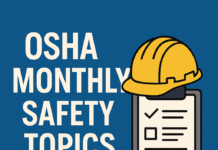
OSHA Safety Engineer Requirements: Ensuring Workplace Safety
Safety in the workplace is a top priority for any organization, and OSHA (Occupational Safety and Health Administration) safety engineers play a pivotal role in achieving this goal. These professionals are responsible for implementing and maintaining safety protocols, ensuring that workplaces adhere to OSHA regulations. Let’s delve into the requirements and qualifications necessary to become an OSHA safety engineer.
Role of OSHA Safety Engineers
Responsibilities and Duties
OSHA safety engineers are tasked with developing and implementing safety programs within organizations. They conduct risk assessments, create safety policies, and ensure compliance with OSHA regulations. Their role extends to investigating accidents and recommending corrective actions to prevent future incidents.
Impact on Workplace Safety
The work of OSHA safety engineers directly contributes to creating a safe and secure work environment. Their proactive measures help prevent accidents, protect employees, and ensure that businesses operate in accordance with the highest safety standards.
Educational Background
Required Academic Qualifications
To embark on a career as an OSHA safety engineer, a minimum of a bachelor’s degree in occupational health, safety engineering, or a related field is typically required. Advanced degrees may enhance one’s prospects in the field.
Specialized Certifications and Training
In addition to formal education, OSHA safety engineers often pursue specialized certifications and training programs. Certifications such as the Certified Safety Professional (CSP) or the OSHA 30-Hour Construction Safety Certification are highly valued.
Experience Requirements
Minimum Years of Experience
Most employers seek candidates with a few years of relevant experience. Entry-level positions may require less experience, while senior roles may demand a more extensive track record.
Types of Relevant Experience
Experience in safety management, risk assessment, and familiarity with OSHA regulations are crucial. Many OSHA safety engineers gain experience in related roles before specializing in occupational safety.
Technical Skills
Proficiency in Safety Protocols
A deep understanding of safety protocols and the ability to implement them effectively is a core competency for OSHA safety engineers. This includes knowledge of emergency response procedures and hazard identification.
Knowledge of Industry-Specific Regulations
Different industries may have unique safety requirements. OSHA safety engineers must be well-versed in the specific regulations relevant to the sector in which they work.
Soft Skills
Communication and Interpersonal Skills
Clear communication is essential for OSHA safety engineers. They often collaborate with different departments and levels of an organization, requiring effective interpersonal skills to convey safety protocols and guidelines.
Problem-Solving Abilities
The ability to identify potential safety issues and develop effective solutions is crucial. OSHA safety engineers must be proactive in addressing challenges to maintain a safe work environment.
Legal Knowledge
Understanding of OSHA Laws and Regulations
A comprehensive understanding of OSHA laws and regulations is a fundamental requirement. OSHA safety engineers serve as the link between legal requirements and practical implementation within the workplace.
Role in Ensuring Compliance
Beyond understanding regulations, OSHA safety engineers play a pivotal role in ensuring that organizations comply with OSHA standards. This involves regular audits, inspections, and ongoing monitoring.
Certifications
Essential Certifications for OSHA Safety Engineers
Certain certifications significantly enhance the credibility of OSHA safety engineers. The Certified Industrial Hygienist (CIH) and the Associate Safety Professional (ASP) are examples of certifications that demonstrate a commitment to excellence in the field.
Importance of Staying Up-to-Date
Given the evolving nature of safety standards, OSHA safety engineers must stay current with the latest certifications and industry best practices. Continuous learning is key to professional growth and maintaining expertise.
Industry-Specific Requirements
Variances in Requirements Across Industries
Different industries may have specific safety challenges and regulations. OSHA safety engineers need to adapt their knowledge and strategies to address industry-specific concerns.
Specialized Knowledge for Different Sectors
Whether working in construction, healthcare, or manufacturing, OSHA safety engineers must possess specialized knowledge relevant to their industry. This ensures targeted and effective safety measures.
Continuing Education
Importance of Ongoing Learning
The commitment to ongoing education is a hallmark of successful OSHA safety engineers. Staying informed about new safety technologies, regulations, and industry trends is vital for professional development.
Resources for Staying Current in the Field
Continuing education resources, conferences, and workshops offer opportunities for OSHA safety engineers to expand their knowledge. Engaging with industry publications and online forums also provides valuable insights.
Networking in the Industry
Building Professional Connections
Networking is crucial in any profession, and OSHA safety engineers are no exception. Building connections with peers, attending industry events, and participating in professional organizations enhance career prospects.
Participating in Industry Events
Attending conferences and seminars allows OSHA safety engineers to exchange ideas, stay updated on industry trends, and connect with potential mentors or collaborators.
Challenges Faced by OSHA Safety Engineers
Addressing Common Issues
From resistance to change to navigating complex organizational structures, OSHA safety engineers face various challenges. Understanding and overcoming these challenges is integral to their success.
Navigating Changing Regulations
The regulatory landscape is dynamic, requiring OSHA safety engineers to adapt quickly. Staying informed about regulatory changes and proactively adjusting safety programs is essential.
Career Growth Opportunities
Advancement Within the Field
Experienced OSHA safety engineers may progress to managerial or directorial roles. Leadership positions allow them to shape safety policies at a higher level within organizations.
Potential for Specialization
Specializing in a specific area, such as environmental safety or industrial hygiene, can open up new career avenues for OSHA safety engineers. Specialized expertise is often in high demand.
To become a safety engineer specializing in Occupational Safety and Health Administration (OSHA) standards, individuals typically need to fulfill certain educational and professional requirements. Here is a general outline of the qualifications and steps involved:Educational Requirements:
- Bachelor’s Degree:
- Obtain a bachelor’s degree in a relevant field such as occupational safety, industrial engineering, environmental health and safety, or a related discipline.
- Coursework:
- Complete coursework that covers OSHA regulations, industrial hygiene, risk assessment, safety management, and related topics.
Professional Development:
- Gain Relevant Experience:
- Acquire practical experience in the field through internships, co-op programs, or entry-level positions. This experience should involve hands-on application of safety principles and exposure to OSHA compliance.
- Certifications:
- Consider obtaining relevant certifications such as the Certified Safety Professional (CSP) or the Associate Safety Professional (ASP) offered by the Board of Certified Safety Professionals (BCSP). While these are not specific to OSHA, they demonstrate a commitment to the field.
Knowledge and Skills:
- Understanding of OSHA Regulations:
- Develop a comprehensive understanding of OSHA regulations and guidelines. This includes knowledge of specific industry standards applicable to the type of work or industry you are involved in.
- Risk Assessment and Hazard Identification:
- Acquire skills in conducting risk assessments, identifying hazards, and implementing controls to mitigate risks.
- Communication Skills:
- Develop strong communication skills to effectively convey safety information to various stakeholders, including employees, management, and regulatory authorities.
OSHA-Specific Training:
- OSHA Training Courses:
- Participate in OSHA training courses that provide in-depth knowledge of specific regulations and standards. This might include the OSHA 30-hour or OSHA 10-hour training courses.
- Stay Updated:
- Stay informed about any changes or updates to OSHA regulations. Attend workshops, seminars, or conferences related to OSHA compliance and safety engineering.
Networking and Professional Involvement:
- Join Professional Organizations:
- Become a member of professional organizations related to safety engineering, such as the American Society of Safety Professionals (ASSP) or the National Safety Council.
- Networking:
- Network with other safety professionals, attend industry events, and participate in forums to stay connected with the latest trends and best practices.
Continuous Learning:
- Continuing Education:
- Engage in continuous learning through workshops, webinars, and other professional development opportunities to stay abreast of new safety technologies and methodologies.
By fulfilling these educational, professional, and skill-related requirements, individuals can position themselves for a successful career as a safety engineer specializing in OSHA standards. It's important to note that specific requirements may vary based on the employer and jurisdiction, so staying informed about regional regulations is crucial.Conclusion
In conclusion, becoming an OSHA safety engineer requires a combination of education, experience, and ongoing commitment to professional development. These professionals play a crucial role in shaping safe workplaces, ensuring the well-being of employees, and promoting adherence to OSHA regulations.
How To Become OSHA Safety Manager 2024
How To Become OSHA Safety Engineer 2024
How To Become OSHA Safety Officer 2024
OSHA Fall Protection Plan Requirements
FAQs
- Q: Can I become an OSHA safety engineer with a degree in a related field?
- A: While a related degree is beneficial, specific degrees in occupational health or safety engineering are usually preferred.
- Q: How often should OSHA safety engineers update their certifications?
- A: Regular updates are recommended to stay abreast of evolving safety standards. Aim for recertification every few years.
- Q: Are there industry-specific challenges for OSHA safety engineers?
- A: Yes, industries have unique safety concerns, and OSHA safety engineers must adapt their knowledge to address these challenges.
- Q: What soft skills are crucial for OSHA safety engineers?
- A: Effective communication, interpersonal skills, and problem-solving abilities are essential for success in this field.
- Q: How can OSHA safety engineers stay informed about changing regulations?
- A: Regularly monitoring OSHA publications, participating in industry events, and joining professional networks are effective ways.





















